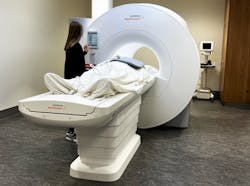Ohio State researchers help design new MRI, expanding access to life-saving imaging
New MRI technology, developed by Siemens in collaboration with researchers at The Ohio State University College of Medicine and College of Engineering, will expand imaging access for patients with implanted medical devices, severe obesity, or claustrophobia.
The Ohio State University Wexner Medical Center said it is the first organization in the United States to install the full body MRI for patient care.
The 0.55T MAGENTOM Free.Max has an opening of 80 cm compared to the typical 60-70 cm, and a lower magnetic field strength that offers the potential for it to be used for lung imaging without X-ray radiation.
MRI is used predominantly to image the brain, spine, and joints but can also be used to image the heart and blood vessels. Today’s clinical MRIs usually have magnetic field strengths of 1.5 or 3.0 Tesla, whereas the Free.Max is much lower at 0.55 Tesla.
“Many of our patients have pacemakers or defibrillators and while many of those devices are now safe for MR scanning, the metal in them can distort the magnetic field and corrupt the image quality. We were looking for ways to improve the quality of images in these patients, and lower magnetic field strength could offer an advantage. The problem with low field MRI is that there is less signal to work with, and we needed to find ways to boost that signal,” said Orlando Simonetti, Research Director of Cardiovascular Magnetic Resonance and Professor of Internal Medicine and Radiology.
The medical center said that Simonetti teamed up with Rizwan Ahmad, Assistant Professor of Biomedical Engineering at Ohio State, to develop techniques that could suppress noise, or interference in the images, and produce clearer images at lower field strength. They shared their ideas and techniques with Siemens, leading to development of the 0.55T Free.Max scanner.
“There’s no doubt in my mind that low-field MRI will play an important role in the future and will become more mainstream,” Simonetti said. “Going to lower field can reduce the cost of MRI systems and installation considerably, and with modern techniques for scanning and image processing, we can overcome the inherent loss of signal.”
Ohio State researchers have partnered with Nationwide Children’s Hospital to study use of the 0.55T with heart catherization. Children with congenital heart disease must undergo repeated heart catheterizations throughout their lives, and they are exposed to radiation every time they have an X-ray to guide the tube through a blood vessel to the heart.
“The doses of radiation accumulate over time and can be harmful, especially to children who are still growing,” Simonetti said. “It may be possible to perform MRI-guided cardiology procedures safely at low field using standard catheters and guidewires; this will be safer for anyone who has to have repeated heart catheterizations and other procedures.”
Ohio State researchers are optimistic that the new MRI technology can also be used to image the lungs, which typically is done with nuclear imaging or X-ray CT scans.
“This is an important advancement for patients with cystic fibrosis, pulmonary hypertension, heart failure, COVID-19 and any other disease where we’re trying to understand the source of shortness of breath and evaluate both the heart and lungs,” Simonetti said. “The air in the lungs cancels out the MRI signal at higher field strength; however, at lower field, there's potential to see lung tissue more clearly with the MRI.”

